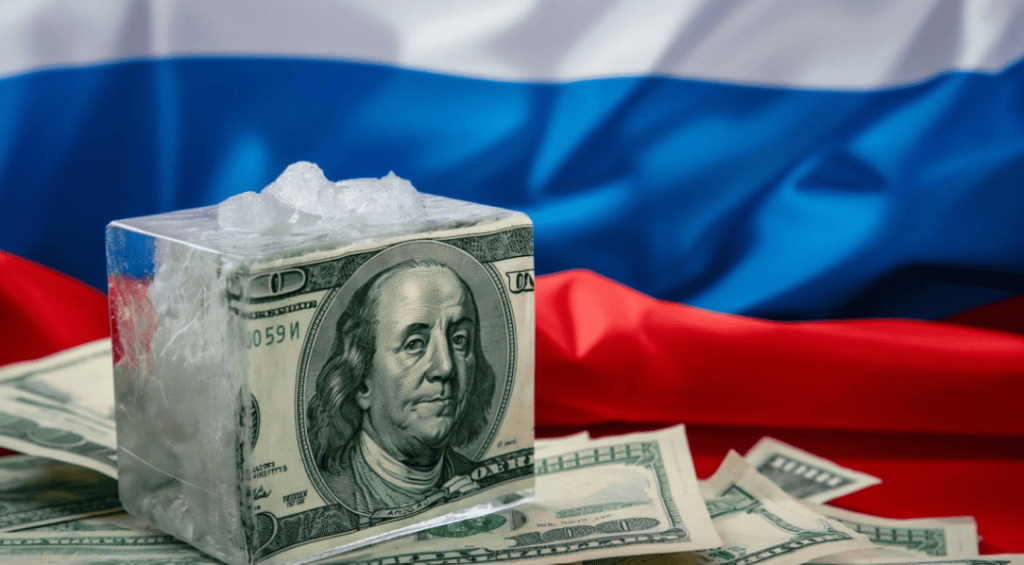Will the freezing of the Bank of Russia’s foreign exchange reserves undermine the dollar’s predominant role in official foreign exchange reserves? This column examines the aggregate evidence since end-2021 for any reduction in the dollar share of official foreign exchange reserves against a baseline constructed with data from 1999 through 2021. The observed dollar share in March 2024 differs little from the out-of-sample projection based on this baseline. On this showing, official reserve managers have not reduced the role of the dollar since the freeze of the Bank of Russia’s assets.
The effective freezing of nearly one-half of the Bank of Russia’s foreign reserves by a broad array of advanced economy governments in February 2022 led to a debate over whether this move would lead to a decline in the role of the dollar in official foreign exchange (FX) reserves. Previous freezes on the central banks of Libya, Iran, Venezuela and Afghanistan did not target hundreds of billions of dollars or such a large country. In this column, we review the aggregate evidence for diversification out of the dollar by official reserve managers since end-2021.
Rebucci and Ahmed (2022) argued that the diminished insurance value of dollar reserves as a result of the freeze could lead to a cut-back in official dollar holdings and higher US Treasury yields. McDowell (2023) cited the precedents of the Russian and Turkish central banks’ selling dollars after multilateral sanctions on Russia in 2014 and 2018, and US bilateral sanctions on Turkey in 2018. 1 Bianchi and Sosa-Padilla (2023) provided a model for how sanctions, by lowering the usability and liquidity (‘convenience yields’) of US dollar reserves, reduce the demand for them.
Others argued that the freeze of the Bank of Russia’s reserves would not lead to a decline of the predominance of dollar reserves. James et al (2022) argued that there is no good alternative to the dollar. Folkerts-Landau et al (2022) argued that the Russian asset seizure is consistent with the function of dollar reserves as collateral given to raise the cost of misbehaviour. Weiss (2022) argued that fear of US sanctions would not have a large aggregate effect, because the bulk of world FX reserves are held by countries more or less aligned with the US. Indeed, the breadth of the coalition of countries that froze the Russian central bank’s reserves highlighted such alignment.
In empirical testing in a panel of country-level data, Goldberg and Hannaoui (2024) do not find that financial sanctions by the US are associated with a lower dollar share of official FX reserves. Chinn et al. (2024) report similar results, both from a regression of the dollar share alone or from a pooled regression including other reserve currencies. By contrast, Arslanalp et al. (2023) find that financial sanctions do lead to an increase in gold as a share of overall reserves.
Weiss (2022) puts the spotlight on China, the largest FX reserve holder at some distance geopolitically from the US. Weiss (2023) finds that China (both the private and official sectors) was one of the largest acquirers of US securities in 2022. Setser (2023) also finds that China has not sold dollars. 2
Now, years after the freeze of Russian official FX reserves, is there any evidence of an aggregate shift out of the dollar by official reserve managers? 3 To answer this question, one needs a baseline for the evolution of the dollar reserve share. Does the evolution of the previous determinants of that share since the end of 2021 suggest a shortfall of the observed share? If so, there is room for the interpretation that sanctions are undermining the dollar’s predominance as an official reserve currency.
Two factors provide a baseline against which to judge whether sanctions have led to a reallocation of FX reserves away from the dollar. Arslanalp et al. (2022) highlight a trend decline in the dollar share of about one-half percentage point per year since the inception of the euro in 1999. These authors ascribe the trend to the greater liquidity of minor currencies, reserve managers’ greater emphasis on returns and the very low interest rates on offer on the major reserve currencies.
Chinn et al. (2021, 2022) find that fluctuations in exchange rates account for most of quarterly changes in the dollar share of FX reserves. Some highly professionalised managers of large foreign exchange reserves, like those at the Swiss National Bank, maintain their targeted currency allocations in the face of exchange rate changes. In other words, such reserve managers periodically rebalance their reserves. They sell currencies that have gained value and buy those that have lost value, and thereby prevent dollar appreciation or depreciation from raising or lowering the dollar share. But it turns out that in general reserve managers only partially rebalance their FX holdings in response to exchange-rate valuation gains and losses. Thus, exchange rate changes explain a significant fraction of the fluctuations of the dollar share of FX reserves around its trend.
In Chinn et al. (2021, 2022), quarterly percentage point changes in the dollar share of global FX reserves are regressed on a constant to measure the trend and on the calculated percentage exchange-rate valuation effect on the dollar share. 4 The latter is estimated from the weighted sum of quarterly changes in the dollar price of the reserve currencies broken out by the IMF. 5 An estimated coefficient of one suggests no rebalancing, and a coefficient of zero suggest full rebalancing.
This simple regression of changes in the dollar share produces a reasonable fit for the period 1999Q2 through 2021Q4, accounting for almost two-thirds of the quarterly changes (an adjusted R-squared of .62). As confirmed by den Besten et al. (2023), 7/10ths of the calculated valuation change in the dollar share shows up in the observed change in the share, suggesting that in aggregate rebalancing is only partial. 6 The downward trend is estimated at 0.12% per quarter, or about one-half percent per year. 7
These estimates are combined into a simple baseline to address the question of whether reserve managers have since 2021 reduced their dollar share in a departure from their previous behaviour. Figure 1 shows the out-of-sample evolution of the observed dollar share and its projected share based on the December 2021 observation, the baseline trend and the baseline response to valuation changes.
Figure 1 Dollar share of foreign exchange reserves (%)


Source: IMF Cofer; authors’ calculations.
Note: Projection uses 2021Q4 dollar share of 58.8%, constant of -.121 and coefficient for the effect of valuation change of .735. where the latter two are estimated from quarterly changes in the dollar share over the 91 quarters 1999Q2-2021Q4.
Since 2021, the dollar share has evolved in a manner in line with its behaviour over the period 1999-2021. As it happens, the observed share in blue at end-March 2024 is nearly identical to its share at end-2021. But that was just shy (0.3%, to be precise) of the share that one would expect in red. The effect of the appreciation of the dollar in raising the dollar share barely exceeded the effect of the downtrend. A statistical (‘Chow’) test rejects a structural break after 2021. 8 Taking the nine quarters as a whole, nothing out of the ordinary happened to the dollar share. 9
On this showing, it is hard to argue that the freezing of the Russian reserves and subsequent discussion of seizing them has led official reserve managers to shift their portfolios away from the dollar in favour of other currencies. The latest data suggest that the dollar share of FX reserves is just about where one would expect it to be, given exchange rate changes and the share’s gradual downtrend.
It deserves emphasis that the freeze of Bank of Russia’s assets included holdings denominated in the other major reserve currencies, so it left limited options to avoid a similar future freeze. Renminbi held in China were not included in the freeze, but the IMF reports a decline in the renminbi share of FX reserves from 2.8% at end-2021 to 2.2% in March 2024. While gold may be gaining share in foreign reserves at the margin (Arslanalp et al. 2023), the dollar’s predominance in official FX reserves remains.
Source : VOXeu



































































